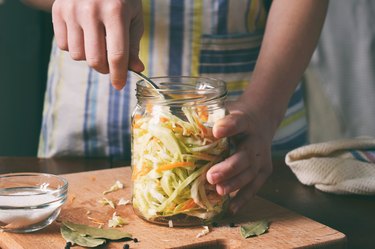
The process of fermenting food at home has been around for centuries — yet many people across the country are only discovering its perks now.
On the most basic level, fermentation is a means to preserve food or beverages for long-term shelf life. There are many different types of fermented items, including yogurt, sourdough bread, kombucha, beer and sauerkraut. Pretty much any fruit or vegetable you like can be fermented!
All fermented fruits and vegetables should taste tangy and bright.
The acidity that helps create these flavors and characteristics comes from the creation of lactic acid as bacteria ferment the sugar in the vegetable or fruit.
Fermenting vs. Pickling
Fermentation occurs when bacteria and yeast break down the natural sugar and starch in food in a no-oxygen environment, turning it into acid and alcohol. This allows it to be stored longer and, in some cases, increases the overall nutrition of the food.
So while fermentation is preservation via a bacterial reaction, pickling is preservation via salt and acid. Fermented foods get their sour flavor from the reaction between the food's sugar and bacteria or yeast while pickled foods get their flavor from an added acid (like vinegar).
The Benefits of Fermenting
Fermented foods often provide better accessibility to nutrients as well as probiotics, which are beneficial microorganisms known for their gut-health benefits.
Since fermentation breaks down foods, it makes some vitamins and minerals more readily available for absorption.
For example, fermented foods have been shown to help increase absorption of iron, making it more bioavailable to humans, according to the February 2015 issue of the European Journal of Nutrition.
It also provides more B vitamins and enzymes as a result of the bacteria and lactic acid that may not have been present beforehand.
Probiotics are valuable to both the digestive system and immune system. Eating foods with probiotics helps create a diverse microbiome, which has been linked to a healthy gut, brain health and increased immunity, according to Harvard Health Publishing.
There are three main types of fermentation:
- Lactic acid fermentation: Microorganisms convert starches and sugars into lactic acid, also known as lacto-fermentation. This method is used in vegetable fermentation as well as yogurt and sourdough bread.
- Ethanol or alcohol fermentation: Yeast breaks down starches and sugars and converts them into alcohol and carbon dioxide. This method produces wine and beer.
- Acetic acid fermentation: The sugars and starches found in grains and fruits are fermented to create vinegar and other condiments. This method creates kombucha and apple cider vinegar.
While all fermented foods and beverages are possible to make at home, we will be focusing on fermented vegetables.
How to Ferment Fruits and Vegetables
What You'll Need
- Easy Fermenter Wide-Mouth Lid Kit ($25.99 on Amazon.com)
- About 5 pounds of veggies (try cabbage, peppers, green beans, asparagus and cucumbers)
- Kosher salt ($6.99 on Amazon.com)
Now that you've got that haul of fruits or vegetables, take a look at our step-by-step guide on how to ferment them.
- Pick out your jars and sterilize them. Wide-mouth jars are best; the most commonly used are glass mason jars or ceramic crocks. To sterilize, wash the jars and lids thoroughly with soap and water. Once dry, pre-heat the oven to 350 degrees Fahrenheit and place them in the oven for 15 minutes. Once cool, they are ready to use.
- Choose your vegetables. You can ferment one vegetable at a time or combine several in one jar. Some popular choices include cabbage, peppers, green beans, asparagus and cucumbers.
- Decide how much salt you'd like to use. Salt promotes both better flavor and the growth of "good" bacteria. The standard ratio is three tablespoons salt per five pounds of vegetables.
- Select lids and weights. Appropriate lids keep oxygen out while weights pack the vegetables tightly and keep them completely submerged. You can create a weight by filling a small resealable plastic bag with rice and placing it on top of the vegetables.
- Wash and process the fruits or vegetables. Depending on the produce, you may want to keep it whole or cut it in strips, chunks or rounds. For sauerkraut specifically, cabbage is typically shredded. Place the fruits or vegetables in a large bowl, add the salt and mix it together well. Place the mixture into your chosen vessel, leaving approximately one to two inches of empty space at the top. Add water, again being sure to leave space above. Close and shake to distribute the salt throughout.
- Cover the mixture and add weight. The fruits or vegetables must be completely covered by liquid, so weighing them down is vital. Remove the lid, make sure everything is submerged and weighed down, then close lid.
- Place the vessels in a clean, dry area, allowing them to sit at room temperature to ferment.
- Check the vessels daily and taste regularly. When you enjoy the level of tang and acidity, it is ready. Depending on your preference, this may take anywhere from two days to two weeks. Once you're happy with the flavor and texture, transfer the vessels to a cooler temperature, such as the refrigerator or a cellar, which should allow it to keep for several months.
Creative Ways to Use Fermented Fruits and Vegetables
Fermented fruits and vegetables are delicious on their own as a snack, but here are some other great ways to integrate them throughout your day.
- Add to grain salads.
- Add to rich or fatty dishes for bright pops of acidity.
- Chop and make into a salsa.
- Add to yogurt or mayonnaise-based salads like tuna, egg or chicken.
- Have a side of fermented fruit or vegetable "chips" with lunch.
- Chop fermented fruit to make a chutney.
- Add fermented jalapenos to a burrito or taco salad.
- Add sauerkraut to a sandwich or burger.